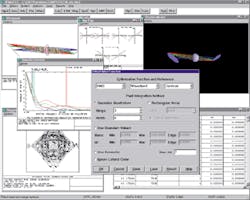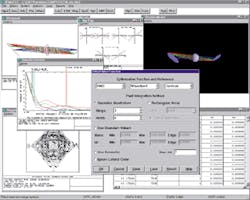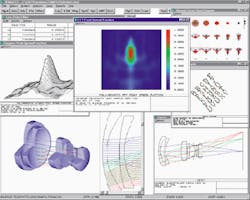Latest ZEMAX creates and evaluates designs
Latest ZEMAX creates and evaluates designs
John Tesar
Optical design software comes from two technology streams: one is derived from the rich heritage of the minicomputer world of aerospace and military applications while the other grew u¥with the microprocessor. The ZEMAX code from Focus Software (Tucson, AZ) is an example of the latter. Introduced during the reign of the Intel 80386 microprocessor, ZEMAX was deemed inadequate by the optical cognoscenti at the time--as was the 386. But with the development of the 80486 chip, no one doubted any longer that extensive optical work could be done with a PC.
The ZEMAX package rode the PC-wave that displaced workstations and minicomputers, as they had displaced mainframes before them. Focus Software incorporated a graphical user interface that eliminated the command-line interface.
ZEMAX 6.0 is the fourth major upgrade of the software. Now new design parameters are entered into spreadsheet-like windows (although they are still called editors). Their tool-bar control panel is the Lens Data Editor, which handles the basic prescription--including radii, glass, and center thickness--with extended parameters for aspheres, gradient indices, coatings, and the like scrolling off on the right side of the resizable window. Rows of buttons above the Lens Data Editor allow the user to open windows for analysis tools such as spot diagrams, ray-fan plots, and optical path differences, as well as the most frequently used functions, including optimization. Buttons on the to¥of the screen and design parameters shown in a tool bar across the bottom can be defined by the user. A full branching menu tops the screen and gives access to all ZEMAX routines.
Many-windowed design tool
Optical designers spend much time building merit functions, running the optimization routines, and evaluating the results with whatever criterion seems appropriate: root mean square (rms) spot, wavefront error, modulation transfer function (MTF), and others (see Fig. 1). It is fairly common to find many windows open. Most designers will be more productive at 1024 ¥ 768 resolution, which allows several graphs, spreadsheets, and output listings to be viewed at the same time. The ZEMAX code supports any resolution supported by Windows. Color depth is not as important; 16-color capability is satisfactory. But computer memory is critical. While ZEMAX can run well on a wide range of computer hardware with as little as 8 Mbyte of RAM, 16 Mbyte is now considered a reasonable minimum. Most engineers will want 32- or even 64-Mbyte RAM for greater performance.
Version 6.0 will run under Windows 3.1, but the preferred operating system for the 32-bit ZEMAX 6.0 is Windows 95 or Windows NT 4.0. The 6.0 code fully exploits the latest capabilities of the Win32 application program interface, including support for long path and file names, multithreaded execution, multiple central processing units (CPUs), the OpenGL interactive graphics, and full 32-bit protected execution (see Fig. 2). Multithreaded operation is important for lens designers, because it allows ZEMAX to perform more than one task at a time within a single session. For example, the program can recompute the diffraction-based MTF or encircled energy in a background window while simultaneously optimizing a lens. The package supports multiple CPU computers, typically Pentium- or Pentium-Pro-based dual- or quad-processor machines. The computational load is divided, each CPU assigned a small piece, and the results recombined by the software. The advantage of such delegation is speed; on a dual-CPU machine ZEMAX can optimize a lens in a little more than half the time required by a single-CPU computer.
Mouse legerdemain
A nice feature of Windows operation is the screen-bottom task bar. Multiple copies of ZEMAX can be simultaneously run and accessed with the click of an appropriate button. Variations on a calculation theme can be applied to several versions of a design file and the most promising results cut and pasted between merit functions and prescriptions. Analysis tools can be double-clicked on for instant updates as the user rotates through the various files and compared with windows that are locked as references.
For those already using ZEMAX, the 6.0 version adds many enhancements and capabilities. There is click-and-drag pan/zoom control on all graphics. False-color, contour, and gray-scale graphics have been added on all three-dimensional isometric plots, such as point-spread diffraction functions, interferograms, and optical transfer functions.
For those designers needing a custom surface type, a new user-defined surface is available. The user-defined surface allows any function to be defined in an external C program, and then the program can be compiled and linked in to ZEMAX to run at native speed. External surface definitions are added to ZEMAX using the standard Windows Dynamic Link Library (DLL) format. The new capability has a tight level of integration. Once the suface DLL is defined, the user-defined properties and column headings show u¥in the ZEMAX user interface and output reports just as if the surface were internally compiled. User-defined surfaces can be used to model refractive, reflective, diffractive, array, or gradient-index components.
This latest upgrade also features support for lenslet arrays in any shape and arrangement. The arbitrary format even allows nonidentical lenses to be arrayed, and the substrate can be reflective, refractive, diffractive, or gradient indexed. There is solid-model rendering using OpenGL graphics. These fully shaded renderings can be interactively rotated at very responsive speeds, even on modest computers. Capabilities include support for click-and-drag pan/zoom complete with user-defined lighting levels, and background colors. Fractional cross sections or full elements of either a subset or the entire assembly can be rendered.
With ZEMAX 6.0, one does not need to be a designer to evaluate designs like manufacturing-yield analysis or problem solving. Such tasks can use the routines for sensitivity analysis by individual element parameters and the running of Monte Carlo simulations. In addition, designs can be evaluated with an eye for their manufacturability. New ZEMAX tolerancing features include full support for compound element tilts and off-centering in the Monte Carlo analysis, sorting of the tolerances by contribution, limiting the output to summary tables, and new statistical model controls.
Other evaluation tools, such as extensive illumination analysis features, have been added to the software. The relative illumination plot is depicted as a function of field and considers apertures, pupil aberrations, vignetting, apodization, thin-film coatings, glass transmission, polarization, and image shape and orientation. There is also a new two-dimensional surface scan showing relative illumination as a function of x and y on the image surface for any arbitrary source shape and includes all the effects listed for the relative illumination plot. o
FIGURE 1. ZEMAX 6.0 has 20 different default merit functions and automatic boundary constraints. The program supports high-resolution graphics for display of multiple open windows.
FIGURE 2. New ZEMAX features include false-color point-spread diffraction function intensity mapping and the OpenGL rendering of the lenses.


